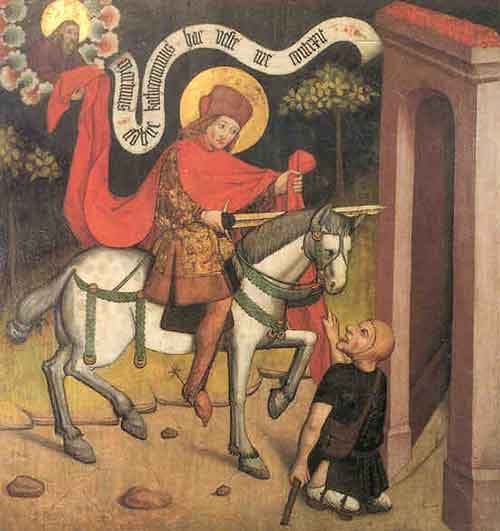
On November 11, it is the commemoration of
The word “chapel” connects to the story of Martin of Tours. The word originates in the early thirteenth century. It literally means “little cape”, and is a diminutive of Late Latin cappa “cape”.
By tradition, the name is originally in reference to the sanctuary in France in which the miraculous cape of St. Martin of Tours, patron saint of France, was preserved. (While serving Rome as a soldier deployed in Gaul, Martin cut his military coat in half to share it with a ragged beggar. That night, Martin dreamed Christ wearing the half-cloak; the half Martin kept was the relic.)
chapel (n.) etymology
A chapel can refer to a part of a larger church building. It is also used for a church building that is part of an institution – a hospital, school, prison,…
Martinmas

There is a pattern – the less we know about a saint, the more significant: St Christopher; St Nicholas; and, today, St Martin of Tours.
11 November is Saint Martin’s day, the Funeral of Saint Martin, Martinstag, Martinmas, Old Halloween, and Old Hallowmas Eve. It is celebrated with music, wine, bonfires, “Martinigansl” (roasted goose), paper lanterns, candles, a man dressed as St. Martin riding on a horse, and so on.
It follows the Octave of the Halloween, All Saints, All Souls Triduum. It concludes Northern Hemisphere Autumn (and the harvest) and begins Winter. Brewed wine and beer is ready. It launches a penitential season as a sort of Carnival. In some countries, Martinmas celebrations begin at the eleventh minute of the eleventh hour of this eleventh day of the eleventh month (cf. the Armistice coming into effect to end the First World War). It was a Medieval “Thanksgiving Day”.
Before Advent was a thing, many Christians fasted on three days a every week from the Feast of Saint Martin to Christmas. This period was called Quadragesima Sancti Martini (Forty Days’ Fast of Saint Martin’s).
A very happy and blessed Martinmas day to you.
*****
Martin, one of the patron saints of France, was born about 330 at Sabaria, the modern Szombathely in Hungary. His early years were spent in Pavia in Italy. After a term of service in the Roman army, he traveled about Europe, and finally settled in Poitiers, whose bishop, Hilary, he had come to admire.
Great Cloud of Witnesses
According to an old legend, while Martin was still a catechumen, he was approached by a poor man, who asked for alms in the name of Christ. Martin, drawing his sword, cut off part of his military cloak and gave it to the beggar. On the following night, Jesus appeared to Martin, clothed in half a cloak, and said to the saints and angels surrounding him, “Martin, a simple catechumen, covered me with this garment.”
Hilary ordained Martin to the presbyterate sometime between 350 and 353, and Martin, inspired by the new monastic movement stemming from Egypt, established a hermitage at nearby Ligugé. To his dismay, he was elected Bishop of Tours in 372. He agreed to serve only if he were allowed to continue his strict, ascetic habit of life. His monastery of Marmoutier, near Tours, had a great influence on the development of Celtic monasticism in Britain, where Ninian, among others, promoted Martin’s ascetic and missionary ideals. The oldest church in Canterbury, which antedates the Anglo-Saxon invasions, is dedicated to St. Martin.
Martin was unpopular with many of his episcopal colleagues, both because of his manner of life and because of his strong opposition to their violent repression of heresy. He was a diligent missionary to the pagan folk of the countryside near his hermitage and was always a staunch defender of the poor and the helpless.
Martin died on November 11, 397. His shrine at Tours became a popular site for pilgrimages and a secure sanctuary for those seeking protection and justice.
Martin of Tours became one of the most popular of all saints and is a patron saint of France. He was born about 316 in Pannonia (modern Hungary), of pagan parents. His father was in the Roman army, and Martin himself became a soldier. Under Constantine as the first Christian emperor, Christianity flourished, but so too did the idea of monasticism or asceticism as an ideal for the committed servant of God.
For all the Saints
Martin was enrolled as a catechumen at an early age, and found his commitment to Christ in conflict with his position as a soldier. He was disciplined for his “conscientious objection”, and eventually discharged from the army. That was the occasion of the famous story of Martin cutting his cloak in two to share with a beggar, and then seeing in a dream Christ wearing half a cloak and saying, “Martin, a simple catechumen, covered me with this garment.”…



That one song she was singing is a children’s song and has different lyrics for that tune in the US.
A tisket, a tasket, a green & yellow basket.
I wrote a letter to my love and on the way, I dropped it.
I dropped it, I dropped it. On the way, I dropped it.
A little doggy picked it up and put it in his pocket.
Thanks, David – the Dutch lyrics make about as much sense 🙂 Blessings.